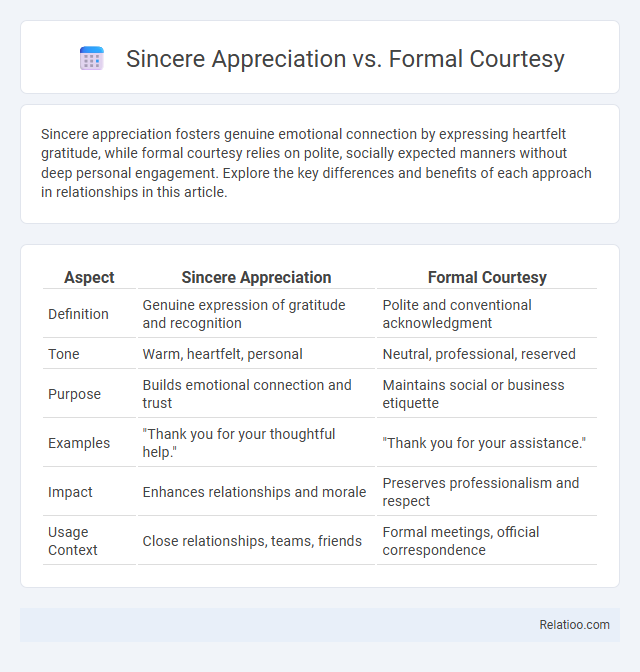Sincere appreciation fosters genuine emotional connection by expressing heartfelt gratitude, while formal courtesy relies on polite, socially expected manners without deep personal engagement. Explore the key differences and benefits of each approach in relationships in this article.
Table of Comparison
| Aspect | Sincere Appreciation | Formal Courtesy |
|---|---|---|
| Definition | Genuine expression of gratitude and recognition | Polite and conventional acknowledgment |
| Tone | Warm, heartfelt, personal | Neutral, professional, reserved |
| Purpose | Builds emotional connection and trust | Maintains social or business etiquette |
| Examples | "Thank you for your thoughtful help." | "Thank you for your assistance." |
| Impact | Enhances relationships and morale | Preserves professionalism and respect |
| Usage Context | Close relationships, teams, friends | Formal meetings, official correspondence |
Understanding Sincere Appreciation
Understanding sincere appreciation involves recognizing genuine gratitude expressed with heartfelt emotion and specific acknowledgment of actions, unlike formal courtesy, which relies on socially expected, often scripted phrases. Sincere appreciation deepens relationships by conveying true value through personal, meaningful communication, whereas courteousness emphasizes polite behavior or manners without necessarily reflecting authentic feeling. To enhance your interpersonal connections, focus on delivering sincerity in your gratitude rather than defaulting to standard expressions of politeness.
Defining Formal Courtesy
Formal courtesy is a structured expression of politeness governed by social norms and professional protocols, often conveyed through standardized language and gestures. It emphasizes respect and decorum in interactions, facilitating smooth communication in official or unfamiliar contexts. Unlike sincere appreciation, which conveys genuine gratitude, and general courteousness, which reflects everyday politeness, formal courtesy maintains a consistent, predictable framework of respectful behavior.
Key Differences Between Appreciation and Courtesy
Sincere appreciation involves genuinely recognizing and valuing someone's actions or qualities, reflecting true gratitude and emotional acknowledgment. Formal courtesy is a socially expected, polite behavior often expressed through established norms without deep emotional involvement. Your understanding of these key differences highlights that appreciation stems from heartfelt feelings, whereas courtesy is typically a structured, external demonstration of respect or politeness.
The Emotional Impact of Sincerity
Sincere appreciation conveys genuine emotions, fostering deep emotional connections and trust between individuals. Formal courtesy often follows social norms without authentic feeling, which may result in polite but emotionally shallow interactions. Courteousness balanced with sincere appreciation enhances relational warmth, making expressions more meaningful and positively impacting emotional well-being.
Cultural Influences on Courtesy and Appreciation
Cultural influences shape the expression of sincere appreciation, formal courtesy, and general courteousness, with collectivist societies often emphasizing formal rituals and hierarchical respect as key components of courtesy. In contrast, individualistic cultures may prioritize genuine emotional expression and personalized acknowledgments as markers of sincere appreciation. Understanding these cultural nuances is essential for effective intercultural communication and fostering mutual respect in diverse social interactions.
Workplace Applications: Which Matters More?
Sincere appreciation fosters genuine connections and boosts employee morale by recognizing individual contributions authentically, while formal courtesy ensures professionalism and clear communication within workplace hierarchies. Courteousness, encompassing respectful behavior and politeness, supports a positive work environment but may lack the deeper emotional impact of sincere appreciation. In workplace applications, sincere appreciation matters more for employee motivation and engagement, whereas formal courtesy maintains organizational structure and professionalism.
Signals of Sincerity vs Signs of Formality
Sincere appreciation is conveyed through genuine emotions, personalized gestures, and heartfelt expressions that signal authenticity and deep gratitude. Formal courtesy, on the other hand, relies on structured language, standardized phrases, and social protocols that indicate respect but may lack personal warmth. Your ability to distinguish between signals of sincerity and signs of formality can enhance meaningful communication by recognizing when appreciation is truly felt versus when it serves merely as polite etiquette.
Benefits of Genuine Appreciation in Relationships
Genuine appreciation fosters trust and deepens emotional connections by validating feelings and actions sincerely, which enhances relationship satisfaction and mutual respect. Unlike formal courtesy or superficial politeness, sincere appreciation encourages open communication and strengthens bonds through authentic acknowledgment. This emotional authenticity reduces misunderstandings and promotes long-term relationship resilience by creating a supportive and affirming environment.
When Formal Courtesy Is Preferred
Formal courtesy is preferred in professional or official interactions where maintaining respect and neutrality is essential, such as business meetings, legal correspondence, or diplomatic communications. Your ability to use formal courtesy ensures clear boundaries and professionalism without the emotional nuance that sincere appreciation conveys. While sincere appreciation involves genuine gratitude and courteousness reflects general politeness, formal courtesy emphasizes standardized expressions to uphold protocol and decorum.
Striking the Right Balance in Communication
Striking the right balance between sincere appreciation, formal courtesy, and courteousness enhances your communication by fostering genuine connections while maintaining professionalism. Authentic expressions of gratitude resonate more deeply than mere formalities, yet polite language ensures respect and smooth interactions. Mastering this balance helps you convey respect effectively, building trust and rapport in both personal and professional contexts.

Infographic: Sincere Appreciation vs Formal Courtesy
 relatioo.com
relatioo.com